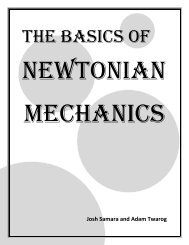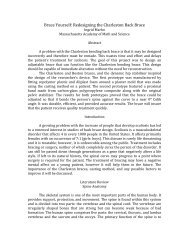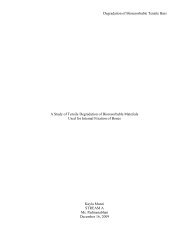Got Food? - the Scientia Review
Got Food? - the Scientia Review
Got Food? - the Scientia Review
You also want an ePaper? Increase the reach of your titles
YUMPU automatically turns print PDFs into web optimized ePapers that Google loves.
The search for sustainable agricultural methods that can secure a stable food supply for future<br />
generations inherently places greater demand on food crop production, animal feed, fiber, and fuels. In<br />
recent years, improved genetics have led to crops receiving private research in <strong>the</strong> hope of dramatically<br />
increasing yields. In nearly all cases, plant genes are moved within or across species, which creates new<br />
combinations based on mutations. The most obvious instance of this has been in U.S. corn production,<br />
which has increased 500% in <strong>the</strong> last 70 years. Today scientists are able to use market-assisted breeding<br />
and biotechnology to better measure and increase <strong>the</strong> precision of DNA alterations. Seed development has<br />
<strong>the</strong> potential to reduce water requirements and fertilizer needed for corn and cotton crops (―Agriculture's<br />
Sustainable Future‖, 2009).<br />
Future Plans<br />
Increasing global awareness of environmental effects of excess carbon has led to plans to reduce<br />
carbon outputs. Five proposed solutions are <strong>the</strong> end of using tropical land for farming, increasing<br />
productivity of initially low-yield farms, improve water usage and waste, reduce fertilizer use, and reduce<br />
meat consumption. Doing such can reduce economic costs and environmental costs simultaneously. There<br />
are core issues that can be addressed which will have a significant effect on sustainability (Jonathan,<br />
2011).<br />
Three major issues that can be addressed are land use, meat consumption, and food waste. All<br />
three of <strong>the</strong>se can be reduced in order to improve <strong>the</strong> sustainability of food production. By <strong>the</strong> year 2050,<br />
<strong>the</strong> world population is expected to reach nine billion. These people will need to be fed, which will cause<br />
an increase in food consumption and <strong>the</strong>refore an increase in food production. An extrapolation of current<br />
statistics regarding food production indicates an impending dilemma. Farming is <strong>the</strong> leading cause of<br />
deforestation, and to some extent, soil erosion. Previous solutions were made without sufficient data of<br />
<strong>the</strong> situation. Each idea only focused on one problem. The overarching problem is caused by <strong>the</strong><br />
combination of <strong>the</strong> individual factors. Recent research has allowed for informed ideas. The proposed plan<br />
includes slowing and stopping clear-cutting land, increasing food production in developing countries, and<br />
using fertilizers strategically. It was also suggested that individuals start consuming more vegetables and<br />
fruits as opposed to meats. In addition, crops used for animal feed uses a significant amount of <strong>the</strong> food<br />
produced globally. Reducing this would provide more food for <strong>the</strong> growing population. (Coren, 2011).<br />
Currently, 38% of global land area (excluding Antarctica and Greenland because of <strong>the</strong> cold<br />
climates of <strong>the</strong>se regions) is used for farming. Although this is not <strong>the</strong> majority of <strong>the</strong> available land, it is<br />
<strong>the</strong> best portion of land. Naturally, <strong>the</strong> most arable sections of land were chosen first. The remaining land<br />
comprises deserts, mountains, and tropical rainforests. Although expanding into <strong>the</strong> rainforests is<br />
possible, and has already occurred, it is not an expedient choice because <strong>the</strong> rainforests are large<br />
consumers of atmospheric carbon dioxide. Clearing <strong>the</strong> rain forests would harm <strong>the</strong> planet greatly<br />
(Jonathan, 2011).<br />
Ideally, food production per unit area should be increased; however, it is not nearly enough to<br />
provide sufficient food for <strong>the</strong> growing population. Global production has been increased by<br />
approximately 20%. This increase is far less than what is needed and is less than what is reported. In<br />
addition, a portion of <strong>the</strong> produced food is not being consumed by people. Alternate uses reduce <strong>the</strong> food<br />
supply by 40%. Also, meat production has a net food loss. The conversion of plant mass to animal mass is<br />
about 30 to one (Jonathan, 2011).<br />
135
















